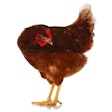Central and state governments sprang into action as officials announced that H5N1 highly pathogenic avian influenza (HPAI) in the Imphal area of Manipur state almost one year after India was declared AI-free. An initial 5km surveillance zone with at least 120,000 chickens and 30,000 ducks had already been set up around the suspect index flock many days before and these were now designated for culling. Over 75,000 of the poultry population were backyard birds with 128 small poultry units and some 60,000 households involved.
Some officials claimed that Manipur is one of the worst possible states for bird flu to strike, being isolated with rugged terrain, rife with separatist violence and porous borders on two sides with Myanmar. However, since the poultry population is relatively small and well away from big centres of production, others suggested it will be easier to eradicate. Observers point out that Imphal is nearer to Bangkok and Dhaka than it is to New Delhi, but repercussions were instantly felt in other parts of India with significant falls in the price of poultrymeat and eggs.
By end of the first day (26 July), almost 10,000 birds had been culled in an operation using JCB diggers and supported by an airlift of 10 sprayers, 20 fogging machines, 1800 masks and 500 personal protection kits to augment the 4000 already in the state. Clearly expecting the worst, medical authorities had already established an isolation ward in the local hospital before AI was announced
Local reports Imphal Free Press (IFP)suggest the operation was delayed by the late arrival of Rapid Response Teams and a high number of medically unfit operators. Authorities said hold-ups were caused by delays in medical checks for the team members. Sangai Express claimed only half the 18,000 cull target was achieved on the first day although progress during the following day was better with 16,000 birds culled. By end of third day (27 July) almost 45,000 birds had been destroyed.
Initial culling focused on four areas of Imphal East and five in Imphal West. State government said it would pay 40 rupees (INR; US$1.0) for every chicken culled. Culling encompassed over 2500 chicks and adult birds at the government-run Central Poultry Farm at Mantripukhri and another 2500 broiler birds at the state broiler farm at Porompat
Quarantine was supposed to be tight butIFP claimed efforts to contain bird flu would almost certainly be undermined by poultry farmers and others transporting poultry out of the designated culling zone to avoid slaughter and to protect their investments.
This apparently huge smuggling operation involving poultry from private farms, and allegedly from the government farms at Porompat, started in the evening of 25 July and continued for whole of the next day. According to IFP, it took place openly with no attempt to stop the vehicles. A Reuters report claimed officialsapprehended and arrested at least one dozen farmers trying to smuggle flocks out the surveillance zone around the index farm in a small village near Chingmeirong.
Sangai Express reported smuggling to be rife with 2000 chicks from Imphal impounded at Ningthoukhang bazaar and 200 and 100 chickens, respectively, at Wabagai Tera Pishak and Sekmaijin. Some poultry farmers refused to hand over birds for culling because compensation was not immediately available, said the report.
Initial prognosis claimed there would be little effect on poultry prices but the price of poultrymeat in New Dehli wholesale markets dropped immediately by 20% (from INR46 to 34/kg), with a significant fall in egg prices (INR153 to 145/100 eggs) reported from Barwala in Haryana State. Barwala is the leading trading centre for eggs in north India. Poultry consumption in Manipur had already dropped during the long wait for bird flu confirmation (please see India’s long wait for bird flu), but actual confirmation and announcement of H5N1 HPAI sent shockwaves through local markets and retail outlets.
According to IFP,prices were slashed to get rid of stocks and chicken meat was available at INR30/kg against usual price of INR80-100/kg. Imphal restaurants that specialise in chicken closed, while others took chicken off of the menu. One day after the announcement of H5N1, the historical Murgi market at Khwairamband was said to be deserted. How much panic was caused by the long period of uncertainty leading up to the announcement, rather than AI itself is an open question.
India’s feed industry does not appear concerned. Amol Sheth of the All India Starch Manufacturers' Association told Reuters that Manipur's poultry industry is small and the outbreak is in an isolated area so health workers should be able to stop the disease spreading. He said India’s poultry industry uses around one half of India's annual maize production of 15 million tonnes, and should remain at that figure unless bird flu gets measurably worse. Rajesh Agrawal, chairman of the Soybean Processors’ Association told Reuters that because few birds were affected and culling is only within an initial radius of 5-10 km of the index flock, there should be no cause to panic. Manipur officials are estimating the total cost to the state economy around INR60 million (US$1.5m).















